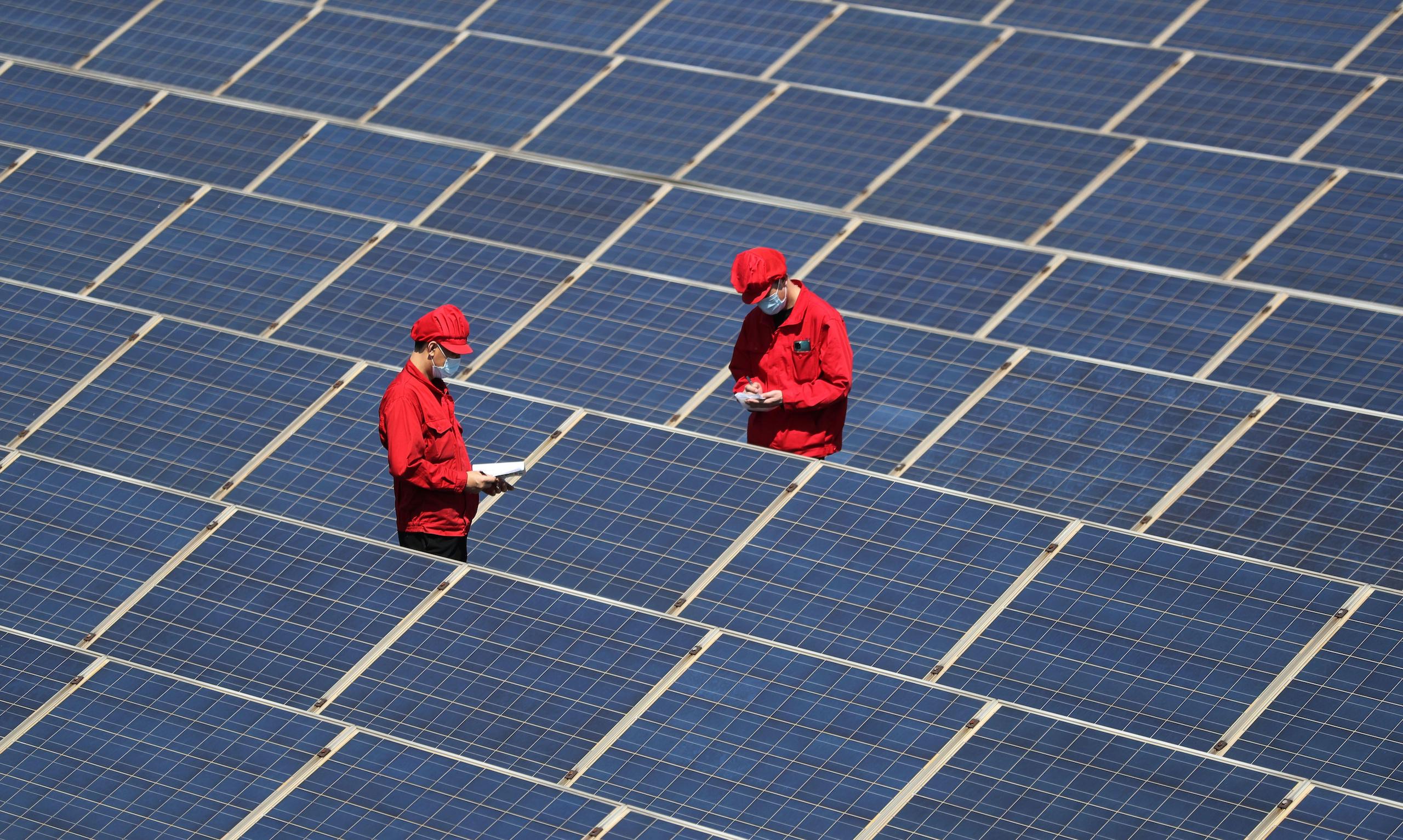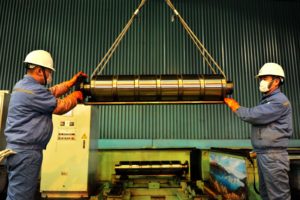Around the world, tech and finance companies have been laying staff off. In 2022, tech firms’ payrolls fell by 164,000 employees, with a further 166,000 jobs cut in the first quarter of 2023, according to tracking platform Layoffs.fyi. In China, youth unemployment is also rising, hitting 20% this April.
Yet for green employment, spring has come. The US, worst hit by the layoffs, saw over 100,000 green jobs advertised in the six months from last August. The share of green employment in the global total rose from 9.6% in 2015 to 13.3% in 2021, according to LinkedIn’s Green Skills Report.
In China, government plans to peak and neutralise national carbon emissions, and for a wholesale green transition, have caused a boom in “green employment”. The sector is expected to employ 1 million people by 2025. The word online is that these jobs can pay as much as 150,000 yuan (US$20,900) per month.
100,000
people in China work in jobs directly linked with the country’s climate goals
According to the 2023 update of the government’s Green Industry Guidance Catalogue, such industries include: energy-saving and carbon-reduction (a service mainly provided by tech companies to big corporations); environmental protection; recycling and reuse of resources; clean energy; ecological protection, restoration and utilisation; green upgrading of infrastructure; and green services (like environmental monitoring and impact assessing). Many of these are emerging sectors, steadily creating jobs.
Meanwhile, regulatory changes since last decade have prompted companies and institutional investors to set up sustainability or ESG (environmental, social and corporate governance) departments, which require staff. Partly driven by such trends, other entities such as academic institutions and media also require more green talent.
Together these form “green employment” – jobs directly in green industries, or in other industries but with a green focus.
So, what do we know about green employment in China?
Policy drivers: decarbonisation targets lead the way
The increase in green jobs is mostly down to policy changes. According to figures from the LinkedIn report, in 2021 there was a big jump in the number of job listings requiring green skills, with those ads accounting for half of the total, far more than the global average. And this came after the share of green jobs in all China’s recruitment had actually been falling since 2017.
The bump may be linked to China’s commitment, made in September 2020, to reach carbon neutrality before 2060. Previously, the environmental sector was focused on air and water pollution, and wildlife conservation. The decarbonisation target prompted a shift towards climate change.
A 2022 report on “decarbonisation employment” from the China-based Climate Action Youth Alliance (CAYA) found that while the emissions-related industry had come into being in 2005 with the signing of the Kyoto Protocol, its size remained small. Even the landmark 2015 Paris Agreement had only a small impact on employment. Things finally changed with the 2060 target, as well as the “1+N” policy framework to guide China’s transition for the next four decades. (The “1” stands for a top-level Guiding Opinion issued in 2021, while the “N” refers to a set of more than 30 sector-specific decarbonisation plans). The number of people whose work is directly associated with the decarbonisation target has now risen from 10,000 to 100,000, according to Caijing Magazine. By 2025, that figure is expected to be somewhere between 500,000 and 1 million.
Zhi Hanzhen, one of the authors of the CAYA report, now works on carbon neutrality and ESG issues for a leading internet company. She graduated with a degree in environmental economics in 2018, unsure of where to work. “Once carbon neutrality became a hot topic, a lot of former classmates came to me for job-hunting advice,” she told China Dialogue. “It’s a relatively new sector and it took me a while to find suitable work. That made me want to use the report to explain carbon employment issues.”
The report splits decarbonisation employment into four main fields: emissions management, emissions auditing, carbon trading, and carbon neutrality tech. Jobs are found in a range of sectors, including energy, industry, buildings, transportation and finance. The biggest employer among these is emissions management consulting, followed by emissions auditing. Most of the 121 survey respondents were working in consultancies or the ESG/sustainability department of companies that outsource their environmental reporting. Zhi Hanzhen also explained that other services are being developed, such as carbon-neutrality communications and training.
The market heats up: ESG and green finance take off
As policy and regulation improved, the green job market heated up and ESG became a hot topic within businesses. ESG covers environmental issues such as climate change and biodiversity, as well as companies’ social impact and governance mechanisms. With regulation and public awareness of environmental issues on the rise, more and more companies set up ESG departments, bolstering their knowledge of social and environmental issues in their day-to-day operations, supply chain management, and disclosures. This helps firms avoid risks and protect brands – and so increase long-term profits. ESG jobs in big businesses or financial firms have become some of the best paid green work available, making them popular with jobseekers.
Du Bowen, who recently started working for a UN body, told China Dialogue he has been lucky enough to find opportunities straddling the internet and ESG. Du became interested in public interest work as a student, and did a master’s degree in humanitarian aid. He graduated in 2015 and spent four years working for two major charities, gaining experience in environmental protection, and poverty and hunger reduction. He then joined Bytedance’s marketing department managing cooperation with international organisations for video-sharing app TikTok. “TikTok set up a Corporate Social Responsibility department around 2020, and employed staff in Europe and the US. The background to this was oversight of internet platforms around the world,” Du explained.
For years, companies outside of directly green sectors like renewable energy saw ESG roles as non-profit-generating, and those employees were put in compliance or marketing departments. The rise of ESG is changing that. According to a 2021 report from Syntao, 1,092 A-listed firms in China (25.3% of the total) published ESG reports in 2020. Regulators and the public read those reports carefully, and the skills and time required to write them has increased, meaning more demand for staff with green skills.
You can’t solve environmental and social issues by relying on people’s goodwillDu Bowen, UN worker
Investors are also putting the pressure on. Data shows that China already has over 130 institutional investors signed up to the UN Supported Principles for Responsible Investment (UN PRI), the bulk of which signed up after 2017. Calculations show that managers of publicly offered funds signed up to the UN PRI account for over half of all China’s publicly offered fund assets. They have committed to taking ESG factors into account when making investment decisions, and to work to improve ESG performance in their investments both by communicating with the firms and using their votes as shareholders.
Zhi Hanzhen said of her time as an ESG manager: “ESG covers a lot of topics. Alongside climate issues such as carbon neutrality we also look at human capital, corporate governance, and other matters investors are concerned about.” She explained that employment in ESG is continuing to increase, and this will be the focus of the next green employment report by CAYA (Climate Action Youth Alliance).
“What I’ve found during my work is that you can’t solve environmental and social issues by relying on people’s goodwill. So I think getting capital involved is a positive trend,” Du Bowen said, referring to investments in green companies as well as investor pressure on all kinds of companies to report and improve upon their ESG performance. “In the past, government oversight was more relaxed, which meant even less motivation. With policy gradually improving and investors providing encouragement, companies are showing more vigour.”
The rise of green finance and the ESG field led to rumours online that an ESG manager could earn 150,000 yuan (US$20,000) a month. Industry insiders told China Dialogue that even if that is achievable, it’s extremely rare. Actual earnings for ESG roles depend on the company. The finance sector, naturally, tends to pay more. But in most sectors, businesses will pay in line with their usual salaries. Once you are out of the finance sector, the CAYA decarbonisation report says, most decarbonisation-related roles pay 10,000-20,000 yuan (US$1,385–2,770) a month. And those jobs tend to be in first-tier cities, mainly Beijing.
Are women the backbone of green employment?
“I’ve got one observation, though I’m not sure if it’s accurate,” Du Bowen said. “A lot of ESG workers are women. If you go to an ESG conference, you’ll see a lot of companies’ ESG officials are women. I think that’s true for the entire Asia-Pacific region.”
Chinese–English bilingual environmental podcast Environment China has also pointed out that the sustainability field tends to be female-dominated. This prompted it to start a series of episodes focused on young workers in the field. Guests have included many successful young women such as an embassy official working on green finance, a sustainability manager for a consumer products firm, and an environmental NGO founder. Yuan Xiaodan, creator of the podcast and former executive director of the Beijing Energy Network, told China Dialogue: “The green sector is a very broad category. Overall, I think the number of women isn’t small and they are usually very active.”
That perception can be backed up. An RBC Global Assets Management study once found women clients were twice as likely as their male counterparts to promote ESG issues. Du Bowen commented this may be because ESG includes gender equality issues and inclusiveness.
But analysis based on wider datasets is more conservative. LinkedIn’s Green Skills Report found that between 2015 and 2021, for every 100 men considered “green talent”, there were only 62 women. The proportion of green jobs in overall employment is increasing, though men are moving into the sector faster. But the report also pointed out that in half of the surveyed countries, the gender gap had shrunk somewhat, with growth in women as green talent increasing faster than in men. These countries were mostly European.
“Green industry is a very broad field. You may find more women in research industries, such as climate change think-tanks and academic institutions, ESG and decarbonisation reporting. You may also find more of them in lifestyle-related industries, such as sustainable catering, second-hand markets and vegetarian food,” said Yuan Xiaodan. “But from what I’ve seen, there’s no shortage of men in the new departments being set up in traditional firms. For example, where car makers are setting up electric vehicle departments or energy firms are setting up renewable energy operations.”
Emerging industries uneven
The “sustainability fever” triggered by policy and market drivers has made the employment market more complicated.
First, the jobs available are a mixed bag. “Once the 2060 carbon neutrality target was announced there was a rush to cut carbon emissions,” said Yang Yifan, sustainable development manager for the China office of dairy alternatives producer Oatly, speaking on the Environment China podcast. “But a problem I’ve noticed is that, despite that rush, there’s still a lack of accumulated knowledge and talent backing it up. So we see cases of greenwashing, such as the sudden appearance of lots of ‘zero carbon’ products on the market.”
China Dialogue explored the problem of corporate greenwashing in some detail in 2021.
Yang also pointed out that this makes achieving zero carbon seem easier than it is. “Those in the field need to do their work and help consumers realise what impact their choices have on carbon emissions and what that means for the planet.”
The CAYA decarbonisation report found many jobseekers in the field are new arrivals who think the policy changes provide an opportunity for career advancement. These often unsuitable applicants are looking more at the prospects of the employer or the sector, than opportunities for personal growth and learning. Zhi Hanzhen told China Dialogue: “They might not have the necessary resources to understand what the work really involves, leading to a mismatch between their expectations and reality.”
Companies struggle to recruit staff who have the skills and knowledge they need, with mid- and high-level talent particularly hard to find. For jobseekers, meanwhile, it can be hard to find and understand information about the jobs, and then they may discover the work is not what they expected. Posts are also concentrated in first-tier cities.
A major reason for this might be problems with the education system. According to CAYA’s report, almost half of jobseekers in the carbon field graduated with a degree related to the environment. But there are few degrees in China specifically covering climate change and decarbonisation, nor is there a system in place for training in these fields. Degrees which might look relevant – environmental engineering or environmental science, for example – still focus on handling air and water pollution, with few if any classes on carbon topics.
During the latest Two Sessions – the annual meeting of China’s top legislature – a proposal on training “carbon talent” was submitted by a member of the Chinese People’s Political Consultative Conference. It noted the lack of high-level technical talent in the carbon sector, and suggested training should include time spent in the workplace.
It can be anticipated that jobs in green sectors such as environmental protection, energy and even sustainable consumption will further increase in the future. And the lack of green talent serves as an indicator of what the transition requires from the Chinese education and labour markets.










